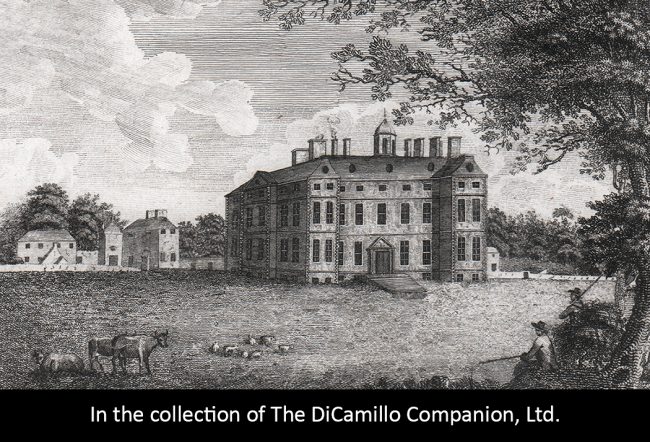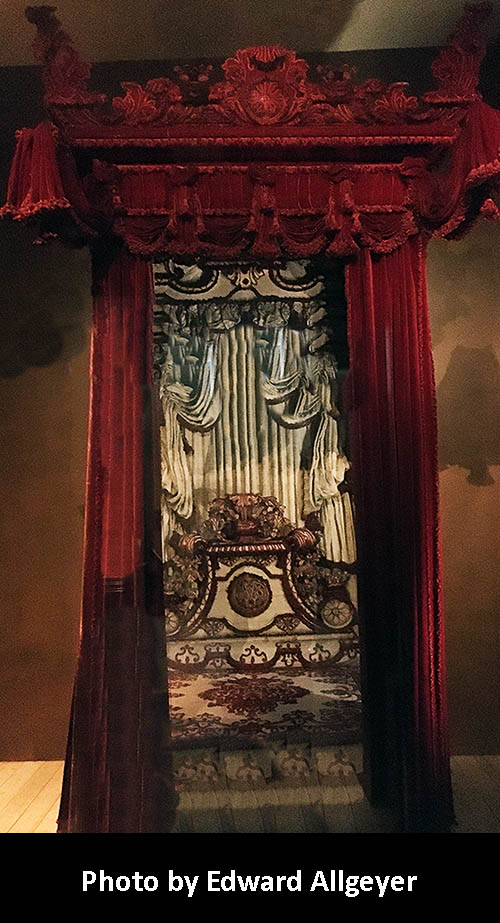
The house from a 1798 copperplate engraving

The Melville State Bed, today in the collection of the V&A.
Earlier Houses: An earlier house, the 14th century Monimail Palace, a country house of the bishops of St. Andrews, was abandoned in the late 17th century. The remains of this great house, today the Grade A-listed Monimail Tower, were incorporated into the grounds of Melville House as a folly. On March 23, 1563, Mary, Queen of Scots, had dinner at Monimail Palace.
Built / Designed For: George Melville, 1st Earl of Melville
House & Family History: The 1st Earl of Melville was a senior courtier at the Stuart court and served as William III's secretary of state for Scotland from 1689 until 1691. During World War II Melville House was requisitioned by the British Army and used as a school and guerilla training base for Polish soldiers who were being trained to fight against the anticipated German invasion and occupation of Britain. After the war ended the house served for a brief time as a hospital before being converted into Dalhousie Preparatory School, a purpose it served between 1950 and 1971. In 1975 Melville House was purchased by Fife Regional Council, who, until 1998, ran a special education boarding school for young offenders and children with behavioral issues at the house. Melville House was sold in 2003 for £1 million and converted back into a private residence; in 2008 the house was listed for sale for £4.5 million (the price was reduced to £1.6 million in 2009, after the bank foreclosed on the mortgage).
Collections: The state bed from Melville House (see "Images" section), made for the 1st Earl of Melville circa 1700, has been in the collection of the Victoria & Albert Museum since 1949, when it was sold, together with the rest of the contents of the house. The decoration of the bed was inspired by the designs of Daniel Marot and was probably executed by Francis Lapiere; rather exceptionally, the bed retains its original crimson Genoa velvet hangings and ivory Chinese silk linings and covers.
Garden & Outbuildings: In 1952 a student at Dalhousie Preparatory School was digging up potatoes in the grounds of Melville House when he came upon a 4,000-year-old Egyptian mid-12th Dynasty red sandstone head of a man, which he at first thought was a potato. This ultimately proved to be just the first of 18 Egyptian antiquities unearthed by students on the grounds between 1952 and 1984. Other finds included a circa 664-332 BC bronze votive statuette of an Apis bull, a circa 1069-656 BC bronze figurine of a priest, and a fragment of a Ptolemaic faience plaque depicting the Eye of Horus. Most of the antiquities discovered at Melville are today in the collection of the National Museum of Scotland in Edinburgh. Nobody knows how these pieces of Egyptian history ended up at Melville House. A possibility is that they were collected by Capt. Alexander Leslie-Melville, Lord Balgonie, son and heir of the 8th Earl of Leven. Lord Balgonie visited Egypt in 1856 for his health (he had TB) and may have purchased the antiquities during his visit and brought them back to Melville before his early death in 1857 at the age of 24. Why they were buried in the grounds may remain a mystery forever.
Architect: William Bruce
Date: 1697Architect: James Smith
Date: 1697-1700Vitruvius Britannicus: C. II, pl. 50, 1717.
Country Life: XXX, 1006, 1911.
Title: Biographical Dictionary of British Architects, 1600-1840, A - HARDBACK
Author: Colvin, Howard
Year Published: 2008
Reference: pgs. 179, 953
Publisher: New Haven: Yale University Press
ISBN: 9780300125085
Book Type: Hardback
Title: British Galleries, 1500-1900, A Guide Book, The
Author: Winch, Dinah
Year Published: 2001
Publisher: London: Victoria & Albert Museum
ISBN: 1851773622
Book Type: Softback
House Listed: Category A
Park Listed: Listed as a Garden & Designed Landscape
Past Seat / Home of: SEATED AT EARLIER HOUSE: William Lamberton, Bishop of St. Andrews, 14th century. Cardinal David Beaton, until 1546. Sir James Balfour, 1564-83. Sir Robert Melville of Murdocairnie, 1592-1621. SEATED AT CURRENT HOUSE: George Melville, 1st Earl of Melville, 1700-07; David Melville (Leslie), 2nd Earl of Melville and 3rd Earl of Leven, 1707-28; David Leslie, 4th Earl of Leven and 3rd Earl of Melville, 1728-29; Alexander Leslie, 5th Earl of Leven and 4th Earl of Melville, 1729-54; David Leslie, 6th Earl of Leven and 5th Earl of Melville, 1754-1802; Alexander Leslie-Melville, 7th Earl of Leven and 6th Earl of Melville, 1802-20; David Leslie-Melville, 8th Earl of Leven and 7th Earl of Melville, 1820-60; John Thornton Leslie-Melville, 9th Earl of Leven and 8th Earl of Melville, 1860-76; Alexander Leslie-Melville, 10th Earl of Leven and 9th Earl of Melville, 1876-89; Ronald Ruthven Leslie-Melville, 11th Earl of Leven and 10th Earl of Melville, 1889-1906; John David Melville, 12th Earl of Leven and 11th Earl of Melville, 1906-13; Archibald Alexander Leslie-Melville, 13th Earl of Leven and 12th Earl of Melville, 1913-47; Leslie-Melville family here until 1949.
Current Ownership Type: Individual / Family Trust
Primary Current Ownership Use: Private Home
Ownership Details: The west wing of the house and some outbuildings can be booked for holiday accommodation.
House Open to Public: By Appointment
Phone: 01337-380-761
Email: [email protected]
Historic Houses Member: No